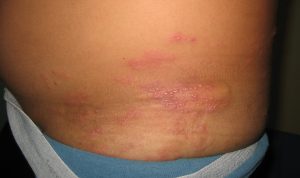Chapter 6: Infections and Infestations
Viral Infections: Zoster (Shingles)
What causes it?
Zoster is caused by the reactivation of VZV and is uncommon in children. Following an episode of varicella, the virus travels down the nerves where it then stays, kept in check by the body’s immune system. If there is a weakening of the immune system, whether from stress, illness, medication, or old age, the virus has a chance to multiply and travel back out the nerve to the skin where it causes blisters and pain. Vaccine-strain VZV can also cause zoster.

What does it look like?
Herpes Zoster is characterized by grouped clear vesicles on an erythematous (red) base. The lesions are found in a dermatomal distribution, which means that they appear on the skin in an area that gets its sensation from a single spinal nerve root. The rash rarely crosses over the midline of the body. Patients with zoster report significant pain at the site and do not have the itch that would be expected with other rashes.
How is it treated?
Getting rapid treatment is important in decreasing and controlling the symptoms of herpes zoster. Treatment with antiviral medications such as acyclovir should be started as soon as possible, ideally within the first 48 hours of lesions appearing. Pain control involves: moist dressings, NSAIDS, and local application of heat or pressure. IV acyclovir is indicated in cases of ophthalmic zoster or zoster in an immunocompromised person.

